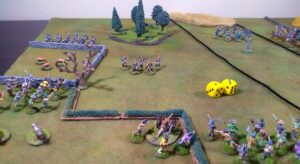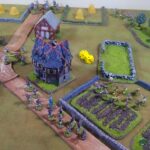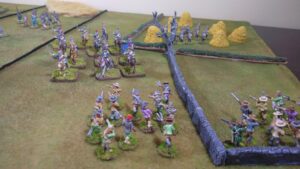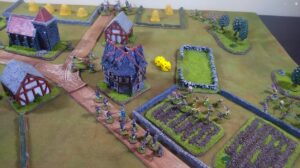
This is yet another entry in the Rampant family, borrowing heavily from titles such as Dragon Rampant and The Men Who Would Be Kings. The activation and combat system are largely the same as we’ve seen in previous titles, but with a few new wrinkles to give them that turn of the 18th century feel.
For one thing, every unit gets a chance to activate now. No more one and done, no more watching your whole force twiddle their thumbs because you tried to activate the wrong unit first. Sure, you might see your whole army stand around, but at least now each unit has a chance to do something. In my head-canon this was done to account for improvements in command and control during this era, particularly when compared to pre-gunpowder eras, but that’s probably just a rationalization.
The base game has been streamlined in some ways. Generally speaking, activation and morale are now a universal, “roll 2d6 and get a six or better to succeed.” In practice you don’t have a Courage score for morale checks, you have a Discipline score that might lead to a bonus or penalty to that morale check. Balancing out that simplification, we have an increase in the complexity of the effects of morale. Previously, units were either fine or battered – you can read that as shaken if you prefer.
Dan and Company have now added a third option; units can be Shaken or even Broken. Instead of hoping to beat that Courage score, now there are two different target numbers. If the result of a morale check is a 3, 4, or 5, the unit earns one shaken counter, which reduces its ability to act and cuts its fighting and shooting dice in half until you spend an action and a successful morale check to remove the Shaken status. (Units at half strength cannot recover from being shaken.) Blow that roll by scoring a two or less and you earn two shaken counters, which puts your unit at “broken”. In this case, they must try to recover and if they fail, they will likely rout off the table. It’s a nice new wrinkle that accounts for not just a loss of strength with casualties, but a loss of command and nerve.
The rules are specifically written for fighting on the North American continent. That date range – from 1754 to 1865 – is pretty large for a miniature wargame, and in most cases, you would be forgiven for harboring some skepticism about how well the game works across that spread. Rebels and Patriots gets away with this thanks to the range of troop types.
We should start with the Cavalry types, which are limited to Light and Heavy. This is not a game for massive, sweeping charges of massed cavalry, and to that end it would feel a bit thin for a true Napoleonic wargame. It is designed for a more infantry focused conflict, with cavalry limited in its presence and role. On the other hand, the inclusion of the Native Foot troop type allows for the inclusion of big bands of primarily melee-capable shock troops that use cover to good effect.
And it is both the de-emphasis of horses and that Native contingent that allow this game to work perfectly for the counter-revolution in the west of France. The Royalist forces consisted in the main of large bands of ill-trained but highly motivated farmers – in the early stages of the fight they were little better than armed mobs, and even as they gained experience and picked up a few pieces of artillery, the Vendeeans never formed a sizable enough contingent of cavalry to counter the traitors that beset them. But they did know the lay of the land, and they were adept at using the bocage and swamps and narrow lanes to counter the better-armed and -horsed enemies of God and the Crown.
The inclusion of a dozen scenarios of fairly moderate complexity also adds to the value. You won’t find a single, “line ’em up and throw ’em at each other” in the mix. The authors use victory conditions, asymmetric army sizes, and detailed terrain specifications to keep things fresh. And I’m looking forward to giving each of them a solid play-through.



